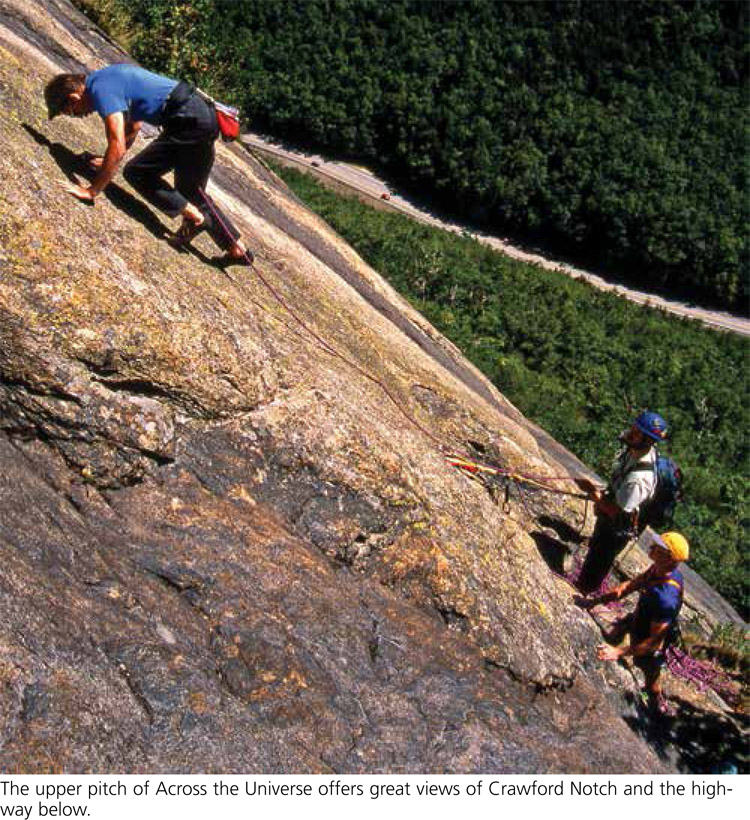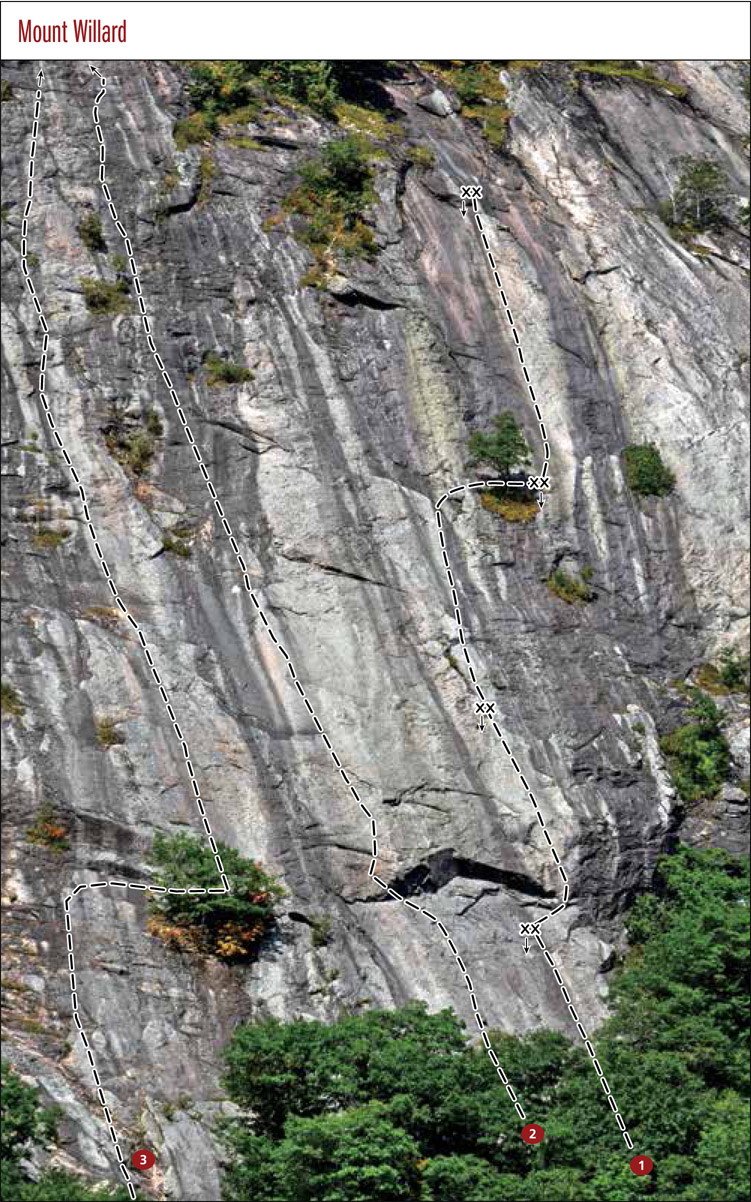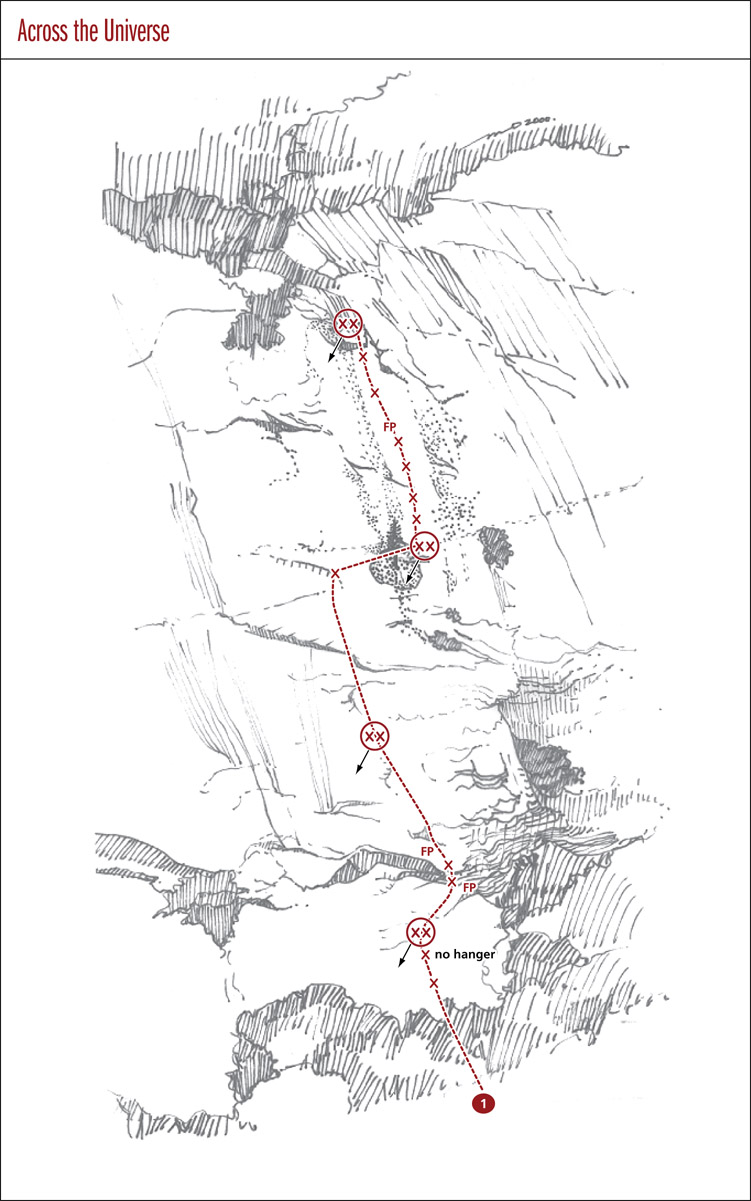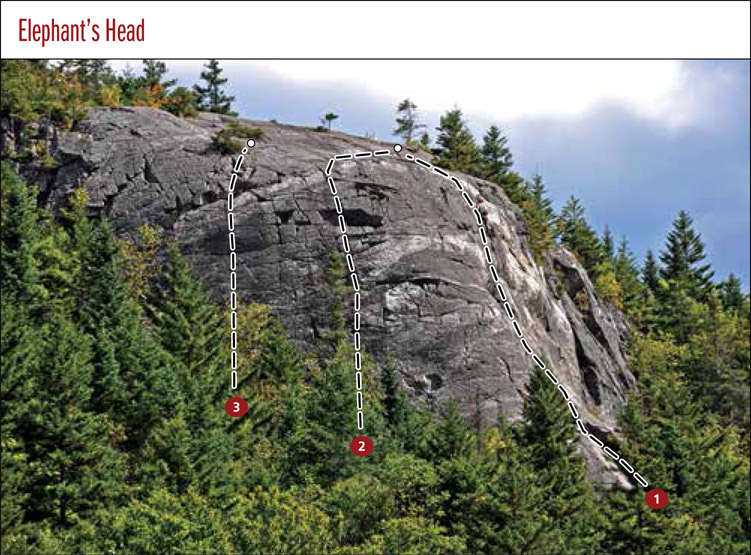
The towering, 800-foot-high southeast face of Mount Willard, overlooking the glacial-sculpted valley of the Saco River below Crawford Notch, yields a selection of good slab routes on its lower wall. The large, rambling granite cliff is naturally divided into an upper wall and a lower wall by a tree-covered terrace. The best rock climbing is found on the lower wall’s slabs, while the steeper upper wall is characterized by generally rotten rock. Mount Willard is also known for its many worthwhile ice routes up the slabs and gullies in winter.
The cliff is sometimes closed from spring through midsummer for nesting peregrine falcons. Signs are posted detailing the closures at the cliff. Across the universe, the route described here, is Willard’s best line and offers superb slab climbing, generally good protection, and the cliff’s best rock. For the other routes on the cliff, consult Webster’s comprehensive guidebook to the White Mountains as well as MountainProject.com.
CLIMBING HISTORY
The obvious face of Mount Willard was first climbed by John Gray and Lincoln O’Brien via the Standard Route (5.6 R) in 1929, after O’Brien and Robert underhill worked out much of the line the previous year. The route was a popular excursion in the succeeding decades before falling out of favor. Today most parties only climb the lower slab pitches and rap off. Other routes on the face were climbed in the 1970s and 1980s by a variety of climbers, notably Todd Swain. Across the universe was established in 1982 by Swain, Mike Cody, and Dick Peterson on their sixth attempt.


Finding the cliff: Follow US 302 from either North Conway to the east or Littleton and I-93 to the west. Park on the top of Crawford Notch at a parking lot on the south side of the highway (GPS: 44.214444 / -71.407800). Hike southeast along the old railroad track grade for 15 minutes until you’re below Cinema Gully, an obvious groove on the left side of the lower slab. Scramble up a climber’s trail that leads up right along the cliff base to a small clearing below the route (GPS: 44.202409 / -71.408658).
1. Across the Universe (III 5.9+) Excellent slab climbing with mostly fixed protection. Pitch 1: Trend up left on the slab and move 10 feet left around a headwall to a hole (#3 Friend). Friction up to a good bolt, continue past another bolt (5.9), and climb past two more bolts to a 2-bolt belay stance below the right side of a triangular-shaped roof. 90 feet. Pitch 2: Edge up right to a fixed piton and do some reachy moves up a headwall right of the roof to clip a bolt. Make a fingertip pull-up (5.9+ or A0) on small holds and reach around an edge to a hidden fixed piton in a shallow corner. Step past the pin, work up right (small Friend or Tri-cam), and run it out up a slab for 40 feet to a 2-bolt belay in an eroded pocket. 140 feet. Pitch 3: Climb straight above the belay on easy, broken rock (5.5) with sparse protection to a shelf. Follow the shelf right (5.2) past a bolt (alternate belay with a 165-foot rope) to a 2-bolt belay behind a tree. 200 feet. Bring a 200-foot (60-meter) rope to do this in one pitch; otherwise, belay at a single bolt and do it in two pitches. Pitch 4: Milky Way Pitch. Stellar climbing! Step right from the belay and smear up the white streak (5.9-) past six bolts and one fixed piton to a 2-bolt anchor below a tree-covered terrace. 160 feet. Carry only quickdraws for this pitch, and leave your rack at the belay. Descent: Three or four double-rope rappels down the route from the bolt anchors atop each pitch. Rack: Not much big stuff—set of wired nuts, small to medium Tri-cams, some small to medium cams, a #2.5 or #3 Friend, and lots of quickdraws. A couple 200-foot (60-meter) ropes are preferable to a couple 165-foot (50-meter) ropes.


The following two multi-pitch routes are on the open slab left of Across the universe. Descriptions are omitted to maintain an adventurous quality. Both, however, have both bolt and gear protection and established bolt anchors for belaying and rappelling.
2. Unknown (5.8).
3. Hugo’s Horror Revisited (5.7).
The Elephant’s Head, a local landmark, is a south-facing cliff perched above US 302 at the top of Crawford Notch. The small crag, shaped like an elephant’s head with a long trunk, is a good area to crank a few easy routes in a picturesque setting. The described route up the trunk is a New Hampshire classic. Other routes and variations are found, including The Ear (5.7), a face route along thin cracks on the face left of the trunk. A couple good ice routes ascend gullies above the highway just east of Elephant’s Head.
Finding the crag: Drive US 302 to the top of Crawford Notch and park in a large parking area on the south side of the road just west of the notch itself (GPS: 44.214444 / -71.407800). The Elephant’s Head rises east of the parking lot. Cross the highway and walk on the north shoulder of the road for a couple hundred feet. Locate a climber’s trail that begins just left of a road cut. The short trail winds uphill to the base of the trunk. Allow 5 minutes of hiking time. The Elephant’s Head Trail begins just west of the parking area at the east end of Saco Lake on the north side of the highway and climbs to the top of the head.

1. The Trunk (5.4) An excellent, easy climb with splendid views of Crawford Notch and the surrounding mountains. Begin just right of the trunk, a slabby prow. Climb good, well-protected rock just left of the trunk with a finish along intermittent cracks at the top. 130 feet. Descent: Walk off the east side of the cliff to the base, or follow the Elephant’s Head Trail back to the parking area. Rack: Medium to large wired nuts and small to medium cams.
2. Right Variation (5.9) Start below the left side of the trunk. Climb slabby rock past the Elephant’s eye and work up left on thin face climbing that quickly moderates past a small roof. Rack: Set of wired nuts and cams to 2 inches.
3. Left Variation (5.8) Fun climbing. Good for toproping. On the left side of the Elephant’s trunk. Start on a ledge with a tree. Climb thin cracks, passing an old fixed piton, to the cliff top. Rack: Set of wired nuts and cams to 2 inches.